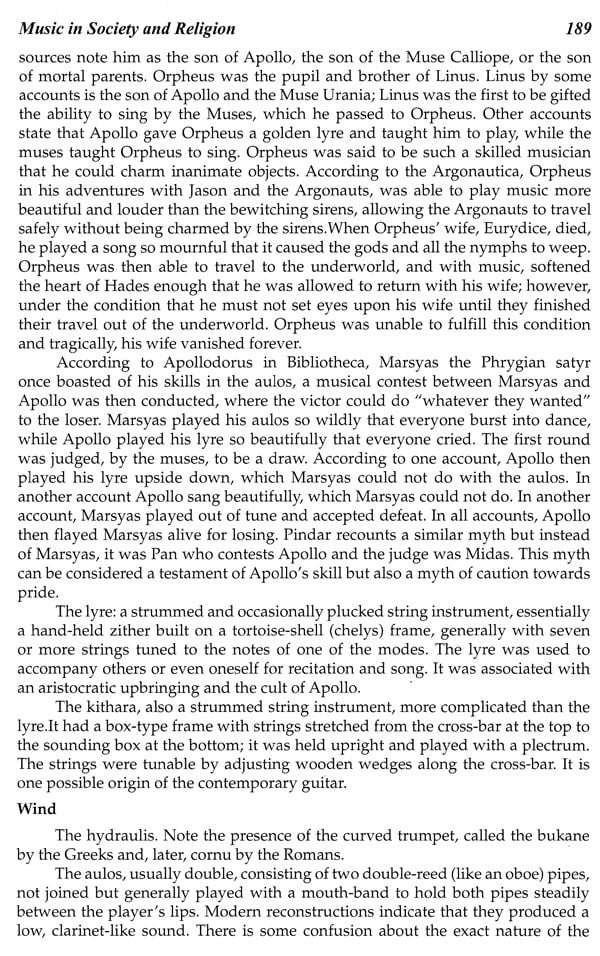
| Item Code: | UAR391 |
| Publisher: | Peridot Literary Books |
| Author: | Nagendra Jha |
| Language: | English |
| Edition: | 2019 |
| ISBN: | 9789389404166 |
| Pages: | 280 |
| Cover: | HARDCOVER |
| Other Details | 9.50 X 6.50 inch |
| Weight | 560 gm |
The tradition of Hindustani music dates back to Vedic times where the hymns in the Sama Veda, an ancient religious text, were sung as Samagana and not chanted. It diverged from Carnatic music around the 13th-14th centuries CE, primarily due to Islamic influences. Developing a strong and diverse tradition over several centuries, it has contemporary traditions established primarily in India but also in Pakistan and Bangladesh. In contrast to Carnatic music, the other main Indian classical music tradition originating from the South, Hindustani music was not only influenced by ancient Hindu musical traditions, historical Vedic philosophy and native Indian sounds but also enriched by the Persianperformance practices of the Mughals. Classical genres are dhrupad, dhamar, khyal, tarana and sadra, and there are also several semi-classical forms. In the earlier days, when Indian music was just coming of age, the music was devotional in nature. It was restricted only to temples and used for ritualistic purposes.
Nagendra Jha is a Professor of Sociology, University of Hyderabad. He achieved his degrees M.A. (Sociaology) and PhD (Moral Values of Hinduism in Veda) from BHU, Varanasi. He is a teacher of Dance, Music and Indian Philosophy. He has specialized in Indian Dance and Music. He has also specialized in Indian Philosophy, Hinduism, Jainism and Buddhism. He has authored more than three books and over twenty five research papers and articles published in national and international journals. He has travelled widely teaching Indian philosophy and culture.
The tradition of Hindustani music dates back to Vedic times where the hymns in the Sama Veda, an ancient religious text, were sung as Samagana and not chanted. It diverged from Carnatic music around the 13th-14th centuries CE, primarily due to Islamic influences. Developing a strong and diverse tradition over several centuries, it has contemporary traditions established primarily in India but also in Pakistan and Bangladesh. In contrast to Carnatic music, the other main Indian classical music tradition originating from the South, Hindustani music was not only influenced by ancient Hindu musical traditions, historical Vedic philosophy and native Indian sounds but also enriched by the Persianperformance practices of the Mughals. Classical genres are dhrupad, dhamar, khyal, tarana and sadra, and there are also several semi-classical forms. In the earlier days, when Indian music was just coming of age, the music was devotional in nature. It was restricted only to temples and used for ritualistic purposes. It is said that the sound that pervades the whole universe, i.e. The earliest Raga is speculated to be "Sama Raga. Theories and treatises began to be written, how the primitive sound 'Om' gave rise to the various notes.
Indian music got divided after the 14th century. Hindustani music seems to have been profusely influenced by the music of Persia and Arabia. It emphasizes on the musical structure and the possibilities of improvisation in it. The main architect of the existing system of Hindustani music was Pandit V N Bhatkhande, who was responsible for the classification of the Ragas into the 10 'thats'. Hindustani music has a number of embellishments and ornamentations or Gamaks like Meend, Kana, Murki, etc. which enhances its aesthetic appeal. The tabla plays a very important role in maintaining the rhythm during a Hindustani concert. There are a number of Tals like Ek-Tal, Jhap-Tal, Dadra, Teen-Tal and so on. Each Tal has its own characteristics.
Indian classical music is the classical music of the Indian subcontinent. It has two major traditions: the North Indian classical music tradition is called Hindustani, while the South Indian expression is called Carnatic. These traditions were not distinct till about the 16th century. There on, during the turmoils of Islamic rule period of the Indian subcontinent, the traditions separated and evolved into distinct forms, Hindustani music emphasizes improvisation and exploring all aspects of a raga, while Carnatic performances tend to be short and composition based. However, the two systems continue to have more common features than differences.
The roots of the classical music of India are found in the Vedic literature of Hinduism and the ancient Natyashastra, the classic Sanskrit text on performance arts by Bharata Muni. The 13th century Sanskrit text Sangita-Ratnakara of Sarangadeva is regarded as the definitive text by both the Hindustani music and the Carnatic music traditions.
Indian classical music has two foundational elements, raga and tala. The raga, based on swara (notes including microtones), forms the fabric of a melodic structure, while the tala measures the time cycle. The raga gives an artist a palette to build the melody from sounds, while the tala provides them with a creative framework for rhythmic improvisation using time. In Indian classical the space between the notes is often more important than the notes themselves, and it does not have Western classical concepts such as harmony, counterpoint, chords, or modulation. Prehistoric music
**Contents and Sample Pages**













Send as free online greeting card
